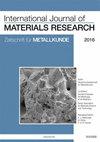A simple and cost-effective synthesis of graphene oxide stabilized glucose-capped copper oxide nanoparticles and its antibacterial properties
IF 0.7
4区 材料科学
Q4 METALLURGY & METALLURGICAL ENGINEERING
引用次数: 0
Abstract
A simple and cost-effective approach has been used to synthesize biocompatible nanocomposites of graphene oxide, glucose and copper oxide. Basically, three types of nanocomposites (i.e., Glucose-capped copper oxide nanoparticles, GO stabilized copper oxide nanoparticles and GO stabilized glucose-capped copper oxide nanoparticles) are synthesized at 35, 75, and 100°C. All the nanocomposites are characterized for their physical properties and studied for their antibacterial properties. Antibacterial testing against laboratory strains of Escherichia coli and Bacillus anthracis shows that all the nanocomposites synthesized at 35°C possess better antibacterial activities compared to other nanocomposites and GO. In this study, the order of antibacterial activity for synthesized nanocomposites observed is Cu/Glu/GO > Cu/Glu > Cu/GO, suggesting that the Cu/Glu/GO possess comparatively significant antibacterial properties owing to the synergistic effect of copper, glucose and GO. However, it should be further explored to be an alternative antibacterial agent to overcome antimicrobial resistance in near future.一种简单而经济的氧化石墨烯稳定葡萄糖包覆氧化铜纳米颗粒的合成及其抗菌性能
一种简单而经济的方法被用于合成生物相容性的氧化石墨烯、葡萄糖和氧化铜纳米复合材料。基本上,三种类型的纳米复合材料(即葡萄糖包覆的氧化铜纳米颗粒,氧化石墨烯稳定的氧化铜纳米颗粒和氧化石墨烯稳定的葡萄糖包覆的氧化铜纳米颗粒)在35、75和100℃下合成。对所制备的纳米复合材料进行了物理性能表征,并对其抗菌性能进行了研究。对大肠杆菌和炭疽芽孢杆菌的抑菌实验表明,35℃合成的纳米复合材料比其他纳米复合材料和氧化石墨烯具有更好的抑菌活性。在本研究中,观察到合成的纳米复合材料的抗菌活性顺序为Cu/Glu/GO > Cu/Glu > Cu/GO,说明Cu/Glu/GO具有比较显著的抗菌性能,这是由于铜、葡萄糖和GO的协同作用。然而,在不久的将来,它应该进一步探索作为一种替代抗菌剂来克服抗菌素耐药性。
本文章由计算机程序翻译,如有差异,请以英文原文为准。
求助全文
约1分钟内获得全文
求助全文
来源期刊
CiteScore
1.30
自引率
12.50%
发文量
119
审稿时长
6.4 months
期刊介绍:
The International Journal of Materials Research (IJMR) publishes original high quality experimental and theoretical papers and reviews on basic and applied research in the field of materials science and engineering, with focus on synthesis, processing, constitution, and properties of all classes of materials. Particular emphasis is placed on microstructural design, phase relations, computational thermodynamics, and kinetics at the nano to macro scale. Contributions may also focus on progress in advanced characterization techniques. All articles are subject to thorough, independent peer review.

 求助内容:
求助内容: 应助结果提醒方式:
应助结果提醒方式:


